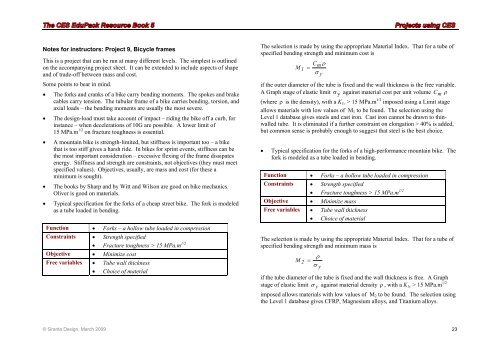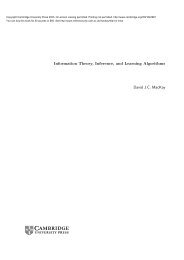Projects Using CES EduPack - MAELabs UCSD
Projects Using CES EduPack - MAELabs UCSD
Projects Using CES EduPack - MAELabs UCSD
You also want an ePaper? Increase the reach of your titles
YUMPU automatically turns print PDFs into web optimized ePapers that Google loves.
Notes for instructors: Project 9, Bicycle frames<br />
This is a project that can be run at many different levels. The simplest is outlined<br />
on the accompanying project sheet. It can be extended to include aspects of shape<br />
and of trade-off between mass and cost.<br />
Some points to bear in mind.<br />
• The forks and cranks of a bike carry bending moments. The spokes and brake<br />
cables carry tension. The tubular frame of a bike carries bending, torsion, and<br />
axial loads – the bending moments are usually the most severe.<br />
• The design-load must take account of impact – riding the bike off a curb, for<br />
instance – when decelerations of 10G are possible. A lower limit of<br />
15 MPa.m 1/2 on fracture toughness is essential.<br />
• A mountain bike is strength-limited, but stiffness is important too – a bike<br />
that is too stiff gives a harsh ride. In bikes for sprint events, stiffness can be<br />
the most important consideration – excessive flexing of the frame dissipates<br />
energy. Stiffness and strength are constraints, not objectives (they must meet<br />
specified values). Objectives, usually, are mass and cost (for these a<br />
minimum is sought).<br />
• The books by Sharp and by Witt and Wilson are good on bike mechanics.<br />
Oliver is good on materials.<br />
• Typical specification for the forks of a cheap street bike. The fork is modeled<br />
as a tube loaded in bending.<br />
Function • Forks – a hollow tube loaded in compression<br />
Constraints • Strength specified<br />
• Fracture toughness > 15 MPa.m 1/2<br />
Objective • Minimize cost<br />
Free variables • Tube wall thickness<br />
• Choice of material<br />
The selection is made by using the appropriate Material Index. That for a tube of<br />
specified bending strength and minimum cost is<br />
Cm<br />
ρ<br />
M 1 =<br />
σ y<br />
if the outer diameter of the tube is fixed and the wall thickness is the free variable.<br />
A Graph stage of elastic limit σ y against material cost per unit volume C m ρ<br />
(where ρ is the density), with a K1c<br />
> 15 MPa.m 1/2 imposed using a Limit stage<br />
allows materials with low values of M1 to be found. The selection using the<br />
Level 1 database gives steels and cast iron. Cast iron cannot be drawn to thinwalled<br />
tube. It is eliminated if a further constraint on elongation > 40% is added,<br />
but common sense is probably enough to suggest that steel is the best choice.<br />
• Typical specification for the forks of a high-performance mountain bike. The<br />
fork is modeled as a tube loaded in bending.<br />
Function • Forks – a hollow tube loaded in compression<br />
Constraints • Strength specified<br />
• Fracture toughness > 15 MPa.m 1/2<br />
Objective • Minimize mass<br />
Free variables • Tube wall thickness<br />
• Choice of material<br />
The selection is made by using the appropriate Material Index. That for a tube of<br />
specified bending strength and minimum mass is<br />
M 2<br />
ρ<br />
=<br />
σ y<br />
if the tube diameter of the tube is fixed and the wall thickness is free. A Graph<br />
stage of elastic limit σ y against material density ρ , with a K1c > 15 MPa.m 1/2<br />
imposed allows materials with low values of M2 to be found. The selection using<br />
the Level 1 database gives CFRP, Magnesium alloys, and Titanium alloys.<br />
© Granta Design, March 2009 23
















